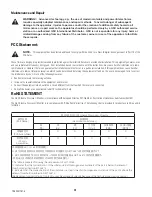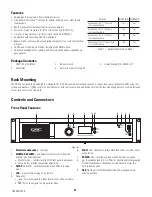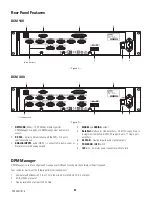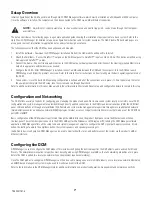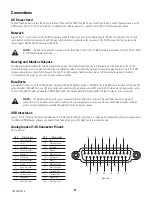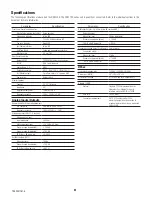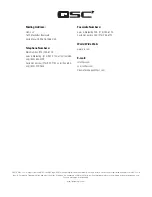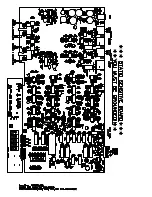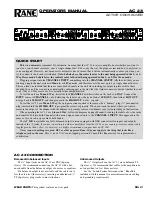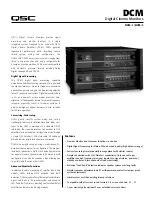
7
TD-000517-01-A
Setup Overview
Initial configuration of the DCM is performed through QSC’s DPM Manager software, which must be installed on a Windows® or MAC computer.
Once the software is installed, the computer can then be connected to the DCM via a USB or Ethernet connection.
NOTE!:
Adjustment of system parameters, such as monitor levels and monitor tap points, can be made through the front panel
user interface.
The Setup Overview on the following pages is a general application guide showing the installation steps required for a basic system. Refer to the
Help Files in DPM Manager for detailed setup and configuration instructions and for system examples. The QSC Cinema Products web pages are
also a good source of information for application notes and system design assistance.
The following assumes that the DCM has been unpacked and mounted.
1. Install the Software – Download the DPM Manager installation file from the QSC website and open file to install.
2. Attach the Amplifiers – Connect DataPort™ outputs on the DCM rear panel to DataPort™ inputs on QSC’s DCA or PL3 Series amplifiers using
QSC approved DataPort™ cables.
3. Connect the Audio – Connect cinema audio sources to the DCM rear panel Analog Input connector. Connect the Hearing Impaired Monitor mix
outputs to appropriate external devices as needed.
4. Configure the DCM – After DPM Manager is installed, connect a USB cable between the DCM and the computer. Turn the DCM on, launch
DPM Manager and follow the prompts on screen. Refer to the Help Files for instructions on how to configure the basic operating parameters of
the DCM.
5. Tune System – Once the basic DCM operating configuration is defined and all of the connections are in place, it’s time to power up the rest of
the equipment, complete the DSP setup, tune the system and run through final check.
Refer to additional information in this User Manual and in the software Help Files for additional setup and configuration details to complete this step.
Configuration and Networking
The DCM offers a variety of options for configuring and managing the product and an entire cinema sound system locally or remotely. Local DCM
configuration and system management are provided through directly applied connections to the DCM via universal serial bus (USB), the DCM front
panel LCD and buttons or through a local Ethernet link. Remote and system-wide management are possible through more sophisticated network
implementations and/or via wide area network (WAN) topologies, Internet access or 3rd party subscription services that make use of the DCM third-
party API or SNMP.
Basic configuration of the DCM product is performed through the USB interface on the product front panel or via the Ethernet connection on
the rear panel. The system designer connects to the DCM’s USB port with a Windows or MAC laptop or PC running the DCM Manager software
application. DCM Manager offers all the setup tools and system management objects to configure the DSP signal path, apply crossovers, EQ etc.,
define the routing of audio to the amplifiers, define the system speakers and speaker processing etc.
In addition to basic configuration, DPM Manager can be used to monitor health, status, and performance of the system via the product’s USB or
Ethernet interface.
Configuring the DCM
DPM Manager is used to configure the DCM product. This includes configuring the device properties, the DSP objects, audio and control I/O and
Presets. The network communications properties must be configured using DPM Manager over USB so that all networking properties are in place
before the DCM is added to a local area network (if your deployment requires networking).
Once the DCM product is configured, DPM Manager can then be used to manage one or more DCM products over a local area network. Alternately,
an SNMP-based management system may be used to monitor and control the DCM.
Refer to the information in the DPM Manager Help for additional information on product configuration, management and network connectivity.



